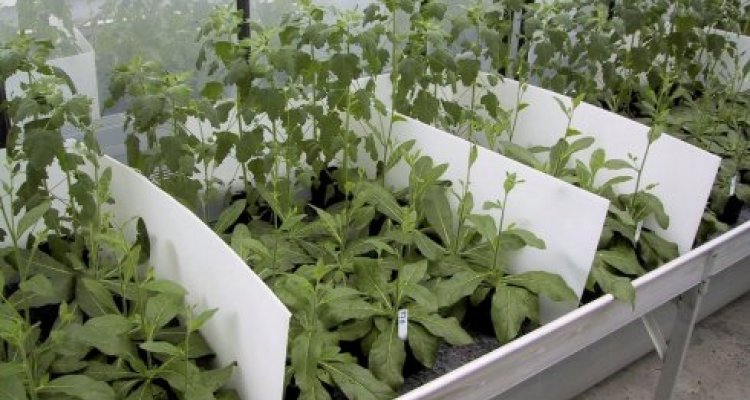
Potato quarantine procedures
Phytosanitary measurements are required by EU Directives to prevent the spread of new potato pathogens from South America into the European Union. The collection of wild and primitive potato species is maintained in the form of botanical seeds. Therefore only true seed transmittable diseases from the quarantine list need to be screened for.
All plants used for rejuvenation are tested by the NVWA (Netherlands Food and Consumer Product Safety Authority (until 2009 Plantenziektenkundige Dienst)) in Wageningen. At the subsequent regeneration, botanical seeds are produced meeting the zero tolerance for quarantine diseases. Following pathogens are being tested:
- Within the EU, Potato spindle tuber viroid (PSTVd) was a Q-organism till December 14, 2019, when it was reclassified as a Regulated Non-Quarantaine Pest (RNQP). The performed testing method "Return" - Polyacrylamide Gel electrophoresis (Huttinga et al., 1987; Roenhorst et al., 2000; Verhoeven et al. 2004; Verhoeven 2010), with a maximum bulking rate of 5 (till the year 2000, a bulking rate of up to 25) was used untill 2020. From 2019 onwards, Real-time (RT-) PCR has been performed on a bulk sample. Both are generic methods for the detection of Pospiviroids (including PSTVd).
True seed transmitted viruses: from 1995-1999, using the indicator plants Chenopodium quinoa (or C. amaranticolor), Nicotiana oxidentalis-P1 and N. bentamiana, maximum bulking rate 5. Starting in 2000 in 2-fold C. quinoa (or C. amaranticolor) and in 4-fold N. hesperis-67A (or N. oxidentalis-P1) (Verhoeven & Roenhorst, 2003). In 2021 N. bentamiana was replaced by N. hesperis-67A. From 2022 onwards only Chenopodium quinoa and Nicotiana oxidentalis-P1 are being used. Furthermore, the potato plants were weekly visually inspected. These procedures include screening for:
- Andean potato latent virus (APLV; preferred name: Tymovirus latandigenum)
- Andean potato mild mosaic virus (APMMV; pref. name: Tymovirus mosandigenum)
- Arracacha virus B - oca strain (AVB-O; pref. name: Cheravirus arracaciae)
- Potato black ringspot virus (PBRsV; pref. name: Nepovirus solani)
- Potato virus T (PVT)
- Potato yellowing virus (PYV; related to Alfalfa Mosaic Virus). In July 1997, the European Commission has put Potato Yellowing Virus (PYV) new on the quarantine list and removed Arracacha virus B from it. However, 3 years later Arracacha virus B is on the list again and PYV removed (Council Directive 2000/29/EC). Recently PYV was put on the list again. The directive is included into the Plant Health Regulations for the Netherlands. Information on Plant Passport obligations in the Netherlands is provided by the Dutch Ministry of Agriculture, Nature and Food Quality. On 14 December 2019 the 2000/29 regulation was replaced by 2016/2031, including extended phytosanitairy obligations and plant passport use for more crops.
- Unknown viruses
Besides the use of indicator plants, from 2021 onwards the NVWA reports having screened the potato germplasm with DAS-ELISA for APLV, APMMV, PBRsV, PVT and PYV. Only in 2022 AVB-O was included for this screening method.

For the test on quarantine viruses, leaves are picked when the potato plants are about 25 cm tall. Three weeks after inoculation of the indicator plants, the results will be available. If symptoms appear on the indicator plants, the potato plants are retested serologically. It is assumed that the indicator plants will also show symptoms of infections with unknown potato viruses. Additionally, all potato plants are visually inspected.
For the most recent true seed import requirements of different countries, download a PDF file per country from NVWA (click on "export land"), only available in Dutch. Several countries do not require an import permit (including an adapted Plant Health Certificate) for material imported for research purposes. Examples of some foreign import requirements include Canada and Chile.
For importing potato germplasm in the Netherlands see (in Dutch): NVWA-import-vergunning, including a link to the import-request-form.
Vegetatively propagated material
Until 1994, the German-Dutch Potato Collection was maintained in Braunschweig, Germany. From 1988 to 1994, screening for quarantine viruses was carried out by the Plant Protection Service of the federal state of Niedersachsen (Pflanzenschutzamt Hannover) using ELISA for APLV (Col, Hu, 300), APMV (B,C,H), AVB-O, PVT, and TRSV-Ca (= PBRsV). The antibodies were produced by the Institute for Biochemistry and Plant Virology of the Federal Biological Research Centre for Agriculture and Forestry (BBA), Braunschweig. Incidentally, APMV (Andean Potato Mottle Virus) is not transmitted via TPS (botanical seed).
In 1986-1987, leaf samples were sent to the Dutch Plant Protection Service in Wageningen and tested with the Latex-agglutination test for APLV & PBRsV. Additionally, indicator plants (C. quinoa, C. amaranticolor & N. clevelandii) were used to screen for APLV, PBRsV, PVT, and unknown viruses.
Within the EU, the user also needs to supply a plant passport when distributing this germplasm or derived material to other users within the EU, in accordance with Council Directive 2000/29/EC (see page 87).